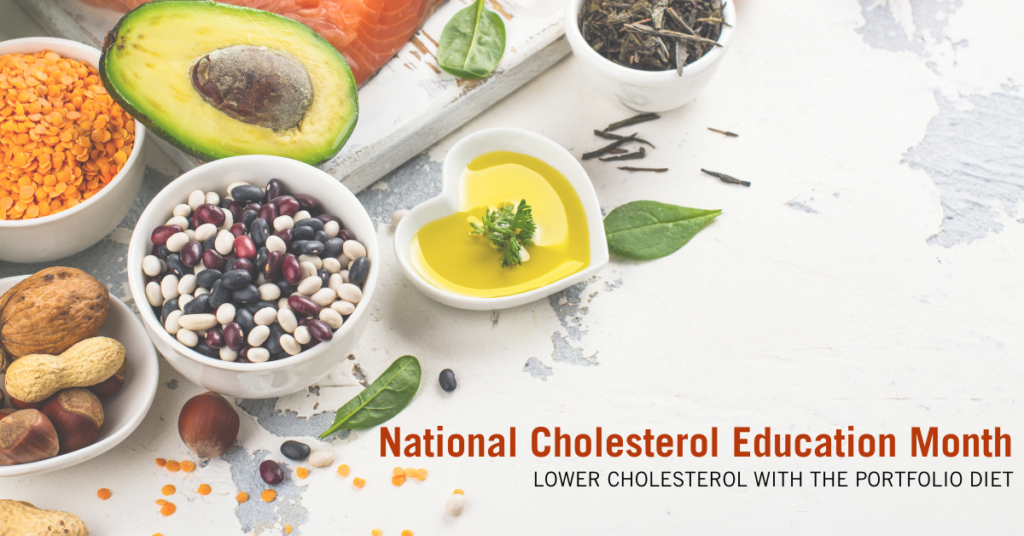Lower Cholesterol with the Portfolio Diet

September is National Cholesterol Education Month, a time to raise awareness about the importance of managing, or lowering, cholesterol through healthy lifestyle modifications. Heart disease remains a leading cause of death worldwide, and taking cholesterol levels into consideration when understanding your risk is pivotal.1
Understanding Lipid Panel Tests and Cholesterol Ranges
Regular monitoring of your cholesterol levels is an important piece of understanding your risk of heart disease. A lipid panel test is a blood test that measures various types of cholesterol and triglyceride levels. Often, this is completed on a yearly basis for most adults, though it may be assessed more frequently if your physician is monitoring for changes related to medication or a previous cardiovascular event. Detailed below are the desirable ranges for different components of the lipid panel.2
LDL (low-density lipoprotein) Cholesterol (often referred to as your “bad” cholesterol):
- Optimal: <100 mg/dL
- Near-Optimal: 100-129 mg/dL
- Borderline High: 130-159 mg/dL
- High: 160-189 mg/dL
- “Very High:” >190mg/dL
HDL (high-density lipoprotein) Cholesterol (often referred to as your “good” cholesterol):
- Men: >40 mg/dL
- Women: >50 mg/dL
Total Cholesterol:
- Desirable: <200 mg/dL
- Borderline High: 200-239 mg/dL
- High: >240 mg/dL
Triglycerides:
- Normal: <150 mg/dL
- Borderline High: 150-199 mg/dL
- High: 200-499 mg/dL
- “Very High:” >500 mg/dL
It is important to discuss any concerns regarding results with your healthcare provider to understand risks and goals related to your personal health.
The Portfolio Diet and Managing Cholesterol
One powerful strategy to support healthy cholesterol levels is the “Portfolio Diet.” Developed by Dr. David J.A. Jenkins, the Portfolio Diet is an evidence-based approach that aims to reduce cholesterol by intentionally combining and consuming foods that are proven to lower cholesterol.3 By incorporating a variety of plant-based, heart-healthy foods, this dietary pattern demonstrates remarkable benefits for individuals seeking to improve their lipid levels.4 This dietary pattern is most effective when incorporated daily, or on most days. Each aspect of the Portfolio Diet may be done in isolation, however, results are often most impactful when all layers of the pattern are implemented.5
Key Components of the Portfolio Diet
1. Plant sterols: These natural compounds can effectively reduce cholesterol absorption as their cellular structure mimics cholesterol in the body. Therefore, these compounds, which are also referred to as “phytosterols,” compete with cholesterol at absorption sites along the digestive system. The body absorbs some of the sterols rather than cholesterol molecules, allowing for cholesterol to be removed as waste. These powerful compounds are found in legumes, nuts, seeds, whole grains, fruits, and vegetables. Some individuals may benefit from plant sterol supplementation; however, this should always be discussed with your dietitian to understand if this is an appropriate strategy for you. Aiming for approximately 2 grams of plant sterols daily may help to lower LDL cholesterol by 5-10%.
2. Soluble fiber: Foods high in soluble fiber have been shown to lower LDL cholesterol levels. Soluble fiber binds to cholesterol within the digestive tract and prevents it from being absorbed into the bloodstream, which can clog arteries. A common dietary source that has been associated with cholesterol-lowering benefits is oatmeal. Other high-quality sources include beans, barley, lentils, apples, and citrus.6 Consuming approximately 18 grams of soluble fiber daily has been shown to lower LDL cholesterol effectively.
3. Nuts: Walnuts, pistachios, almonds, cashews, and other nuts are a wonderful source of heart-healthy fats, plant protein, plant sterols, and fiber. Consuming approximately 1/4 cup of nuts daily as a snack or a component of meals has been shown to lower LDL cholesterol by approximately 5-10%.
4. Plant proteins: Swapping an animal-based protein for a plant-based source such as tofu, tempeh, edamame, legumes, or peas may effectively lower LDL cholesterol by 5-10%. Aim for around 50 grams daily to support heart health.
Strategies to Implement the Portfolio Diet
The Portfolio Diet is not only effective at lowering cholesterol but also boasts many other advantages. By focusing on plant-based foods daily, you will naturally consume a diet that is rich in vitamins, minerals, phytochemicals, and antioxidants – all of which contribute to a decreased risk of chronic disease!
Rather than overhauling all aspects of diet at once, consider these five strategies to support heart health through the Portfolio Diet:1. Swap one snack daily with a serving of nuts and a fruit high in soluble fiber, such as a pear, figs, apricot, nectarine, or apple.
2. Swap one serving daily of rice, pasta, potatoes, or bread with your favorite bean or lentil for a powerful punch of fiber and plant protein.
3. Include oatmeal in your weekly breakfast rotation. Looking for inspiration? Check out our Fiber-Full Blueberry Cinnamon Oats recipe or the Blueberry Banana Protein Oatmeal Bake recipe.
4. Sprinkle salads, oats, and yogurt with ground flax seed for an added boost of soluble fiber.
5. Consider oils high in plant sterols and plant stanols when cooking, such as olive oil, sesame oil, avocado oil, and walnut oil.
If you seek personalized guidance and support in implementing these dietary and lifestyle changes or are interested in learning more, our team of dietitians is here to help! Contact us at info@summerfieldcw.com to connect with a team member today.
Sources:
1.https://www.jacc.org/doi/10.1016/j.jacc.2022.11.005#:~:text=Cardiovascular%20diseases%20(CVDs)%20have%20collectively,and%20excess%20health%20system%20costs
2. https://my.clevelandclinic.org/health/articles/11920-cholesterol-numbers-what-do-they-mean
3. https://www.healthline.com/nutrition/what-is-the-portfolio-diet#downsides
4. https://www.clevelandheartlab.com/blog/the-diet-that-lowers-your-cholesterol-naturally/
5. https://ccs.ca/app/uploads/2020/11/Portfolio_Diet_Scroll_editable_eng.pdf
6. https://www.healthline.com/nutrition/foods-high-in-soluble-fiber

